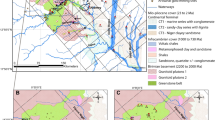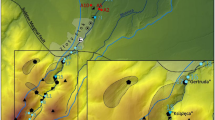Abstract
The aim of this study is to evaluate total arsenic (As) concentrations in drinking water (main pathway of human exposure) and its hydrogeochemical controls in the “Morro do Ouro” gold mine region, which is the largest gold mine in Brazil, characterized by gold-arsenopyrite association. Arsenic concentration was generally below the detection limit (LOD < 0.5 μg L−1). Thus, water ingestion may not be a significant exposure pathway to local population. Low groundwater As concentrations (<1 μg L−1) are likely due to ore body structural setting, which plunges from 10° to >20°, being readily covered by thick phyllites that are poor in As some hundreds of meters away from the mine. Thirty-five percent of As levels in superficial waters (<0.5 to 40 μg L−1) were >10 μg L−1, which is the maximum permissible value for human ingestion. The highest concentrations were found nearby mine facilities and old artisanal mining areas surrounding the mine, decreasing downstream. Undisturbed watersheds showed As concentrations close to LOD. Hydrogeochemical data stress the sorption (adsorption and co-precipitation) of As role, mainly by Fe oxyhydroxides, as a geochemical filter that retains As, attenuating its concentration in both superficial and groundwater. Such minerals are abundant in the region oxisols, sediments, and phyllites and may form stable mineral complexes with As under the pH (mostly neutral) and Eh (reduced environment) conditions found in the field. It has been demonstrated that As(III) (more toxic) and As(V) co-exist in the analyzed waters and that As(V) predominates in superficial water.


Similar content being viewed by others
References
ABC–Associação Brasileira de Cerâmica (2014) www.abceram.org.br
Adriano DC (2001) Trace elements in terrestrial environments: biogeochemistry, bioavailability, and risks of metals, 2nd edn. Springer, New York
Almeida BS, Dardenne NA, Thomson B, Brod JA, Guimarães EM (2009) Geoquímica dos filitos carbonosos da Formação Paracatu, Depósito Morro do Ouro, Minas Gerais. In: Almeida BS (ed) Geoquímica dos filitos carbonosos da Formação Paracatu, Depósito Morro do Ouro, Paracatu, Minas Gerais. Dissertação de Mestrado, n. Instituto de Geociências, Universidade Federal de Brasília, DF, Brasil, p 249
Amaro AS, Venecia Herrera BC, Lictevout E (2014) Spatial distribution of arsenic in the region of Tarapacá, northern Chile. In: Litter MI, Nicolli HB, Meichtry JM, Quici N, Bundschuh J, Bhattacharya P, Naidu R (eds) V International Congress of Arsenic in the Environment—As2014. Buenos Aires, Argentina, CRC Press-Taylor and Francis Group, Proceedings, pp 54–55
ATSDR-Agency for Toxic Substances and Disease Registry (2007) US. Agency for Toxic Substances and Disease Registry. Toxicological Profile for Arsenic, Atlanta, Georgia
Bidone ED, Castilhos ZC, Bertolino LC, Santos MCB, Silva RSV, Cesar RG (2014) Arsenic in soils and sediments from Paracatu, Brazil. In: Litter MI, Nicolli HB, Meichtry JM, Quici N, Bundschuh J, Bhattacharya P, Naidu R (eds) V International Congress of Arsenic in the Environment—As2014. Buenos Aires, Argentina, CRC Press-Taylor and Francis Group, Proceedings, pp 113–115
Carageorgos T, Melamed R (1995) Estabilidade do arsênio proveniente do processamento de arsenopirita para recuperação do ouro: revisão de literatura e estudo de caso. Relatório Técnico RT 01/96, Centro de Tecnologia Mineral, CETEM/MCTI
Cherry JA, Shaikh AV, Tallman DE, Nicholson RV (1979) Arsenic species as an indicator of redox conditions in groundwater. J Hydrol 43:373–392
CONAMA-Brazilian National Council on the Environment (2005) resolution no. 357. http://www.mma.gov.br/port/conama/res/res05/res35705.pdf
Drever JI (1982) The geochemistry of natural waters. Prentice-Hall, Inc., Englewood Cliffs, N.J., 388p
Deschamps E, Matschullat J (eds) (2008) Arsênio antropogênico e natural. Um estudo em regiões do Quadrilátero Ferrífero. Fundação Estadual do Meio Ambiente, Belo Horizonte, 330 p. ISBN 978-85-61029-00-5
Ferreira MM, Patchineelam SR, Castilhos ZC, Calmano W (2013) Sequential extraction of arsenic in sediments of Paracatu, MG, Brazil. Goldschmidt2013 Conference Abstracts, p. 1080, DOI:10.1180/minmag.2013.077.5.6
Figueiredo BR, Borba RP, Angélica RS (2007) Arsenic occurrence in Brazil and human exposure. Environ Geochem Health 29:109–118
Alvarez M, Del P, Trovatto MM, González N, Hernández MA (2014) From the presence of arsenic in natural waters to HACRE. In: Litter MI, Nicolli HB, Meichtry JM, Quici N, Bundschuh J, Bhattacharya P, Naidu R (eds) V International Congress of Arsenic in the Environment—As2014. CRC Press-Taylor and Francis Group, Proceedings, Buenos Aires, Argentina, pp 861–863
Henderson RD (2006) KINROSS—paracatu mine. Technical report., p 179
Hutchinson TC, Meema KM (eds) (1987) Lead, mercury, cadmium and arsenic in the environment. Wiley & Sons, New York
Kabata-Pendias A (2011) Trace elements in soils and plants, 4th edn. CRC Press Taylor & Francis Group, Boca Raton, p 505
Ladeira ACQ, Ciminelli VST, Nepomuceno AL (2002) Seleção de solos para imobilização de arsênio. REM: Revista da Escola de Minas. Ouro Preto 55(3):215–221, jul. set
Langmuir D, Mahoney J, Rowson J (2006) Solubility of amorphous ferric arsenate and crystalline scorodite (FeAsO4.2H2) and their application to arsenic behavior in buried mine tailings. Geochimica et Cosmochimica Act 70:2942–2956
Lopes MC, Lana MS, Ribeiro LFM, Caldeira Silva CH (2007) Geotechnical behavior of weak rocks in Córrego do Sítio mine, Santa Bárbara (MG). REM 40:23–30
Matschullat J (2000) Arsenic in the geosphere—a review. Sci Total Environ 249:297–312
Matschullat J, Borba RP, Deschamps E, Figueiredo BR, Gabrio T, Schwenk M (2000) Human and environmental contamination in the Iron Quadrangle, Brazil. Appl Geochem 15:181–190
Melamed R, Neumann R, Carageorgos T (1996) Estudo de caracterização mineralogica, estabilidade e retenção de arsênio em rejeitos industriais na Rio Paracatu Mineração. Relatório de Projeto RT-29/96, Centro de Tecnologia Mineral, CETEM/MCTI.
Mello JWV, Roy WR, Talbott JL, Stucki JW (2006) Mineralogy and arsenic mobility in arsenic-rich Brazilian soils and sediments. J Soils Sediments 6:9–19
Möller JC, Batelochi M, Akiti Y, Maxwell S, Borges AL (2001) Geologia e caracterização dos recursos minerais de Morro do Ouro, Paracatu, Minas Gerais. In: Pinto CP, Martins-Neto MA (eds) Bacia do São Francisco: geologia e recursos naturais. SBG/MG, Belo Horizonte, pp 199–234
Peakall D, Burger J (2003) Methodologies for assessing exposure to metals: speciation, bioavailability of metals, and ecological host factors. Ecotoxicol Environ Safety 56:110–121
Penrose WR (1975) Arsenic in the marine and aquatic environments: analysis, occurrence and significance. Crit Rev Environ Control 4:465–82
Pettine M, Camusso M, Martinotti W (1992) Dissolved and particulate transport of arsenic and chromium in the Po River. Italy Sci Total Environ 119:253–280
Planer-Friedrich B, London J, McCleskey RB, Nordstrom DK, Wallschläger D (2007) Thioarsenates in geothermal waters of Yellowstone National Park: determination, preservation, and geochemical importance. Environ Sci Technol 41(15):5245–5251
Prohaska T, Stingeder G (2005) Arsenic and arsenic species in environment and human nutrition. In: Cornelis R, Crews H, Caruso J, Heumann KG (eds) Handbook of elemental speciation II: species in the environment, food, medicine and occupational health. John Wiley & Sons, Ltda, pp 69–85
Rabieh S, Hirner V, Matschullat J (2008) Determination of arsenic species in human urine using high-performance liquid-chromatography (HPLC) coupled with inductively coupled plasma-mass spectrometry (ICP-MS). J Anal Atomic Spectrometry 23(3):544–549
Rezende PS, Costa LM, Windmoller CC (2013) Total and trivalent inorganic arsenic determination in water samples by selective hydride generation atomic absorption spectrometry. Br J Anal Chem 10:429–435
Sabadini-Santos E, Bidone ED, Castilhos ZC, Crapez MAC (2014) Microbial activities response to as exposure in soil and sediments surrounding a gold mining area at Paracatu—Brazil. In: Litter MI, Nicolli HB, Meichtry JM, Quici N, Bundschuh J, Bhattacharya P, Naidu R (eds) V International Congress of Arsenic in the Environment—As2014. Buenos Aires, Argentina, CRC Press-Taylor and Francis Group, Proceedings, pp 396–398
Santos MJ (2012) O ouro e a dialética territorial em Paracatu, MG: opulência e resistência. Dissertação de Mestrado-Programa de Planejamento e Gestão Ambiental. UCB, Brasília, DF, p 192
Souza KV, Alamino RCJ, Fernandes FRC (2011) Paracatu: o conflito entre o “Rio Bom” e a mineração. In: Fernandes FRC, Enríques MARS, Alamino RCJ (eds) Recursos minerais & sustentabilidade territorial. CETEM/MCTI, Rio de Janeiro, BR, pp 259–282
Stollenwerk KG (2003) Geochemical processes controlling transport of arsenic in groundwater: a review of adsorption. In: Alan H, Stollenwerk WKG (eds) Arsenic in ground water—geochemistry and occurrence ed. Kluwer Academic Publishers New York, Boston, Dordrecht, London, Moscow, pp 67–100
Tchobanouglous G, Schroeder ED (1987) Water quality. Addison-Wesley Publishing Company, USA, p 768
USEPA-United States Environment Protect Agency (2010) Low stress (low flow) purging and sampling procedure for the collection of groundwater samples from monitoring wells. USEPA Region 1, Quality Assurance Unit, Publication EQASOP-GW 001, January 19, 30 p
Wenzel WW, Blum WEH (1994) Assessment of metal mobility in soil-methodological problems. In: Metal Speciation and Contamination Soil, Allen HE, Huang CP (Eds.), Lewis Publisher.
Acknowledgments
The authors are grateful to CETEM/MCTI (Centro de Tecnologia Mineral do Ministério de Ciência, Tecnologia e Inovação) for funding this study. They also thank REUNI—Programa de Apoio a Planos de Reestruturação e Expansão das Universidades Federais—for the grant of Maria Carla Santos (Doctorate/UFF) and CAPES for the grant of Marcos Ferreira (Doctorate/UFF).
Author information
Authors and Affiliations
Corresponding author
Additional information
Responsible editor: Philippe Garrigues
Rights and permissions
About this article
Cite this article
Bidone, E., Castilhos, Z., Cesar, R. et al. Hydrogeochemistry of arsenic pollution in watersheds influenced by gold mining activities in Paracatu (Minas Gerais State, Brazil). Environ Sci Pollut Res 23, 8546–8555 (2016). https://doi.org/10.1007/s11356-016-6089-3
Received:
Accepted:
Published:
Issue Date:
DOI: https://doi.org/10.1007/s11356-016-6089-3




